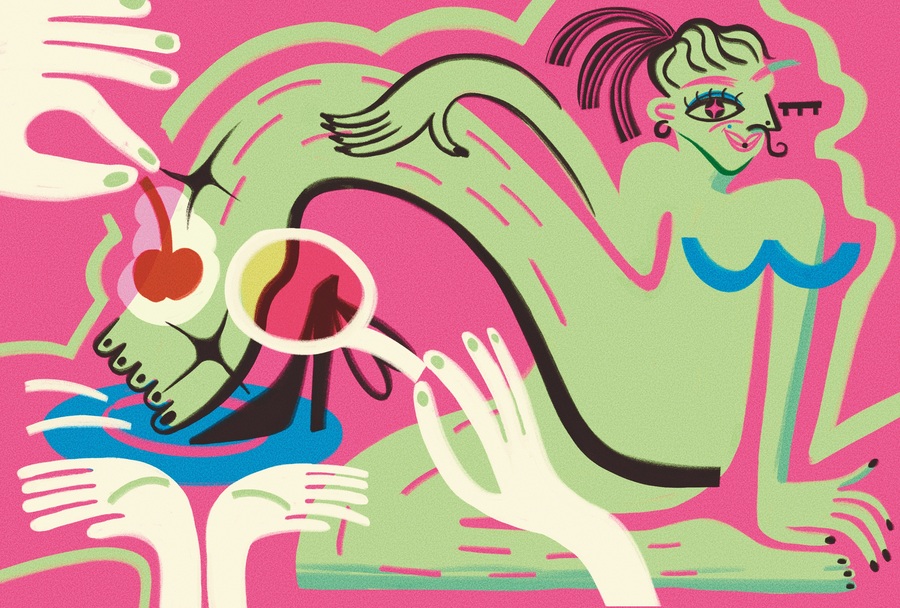Finding Your Feet: How foot fetishes (and other kinks) can reduce STI transmission
When it comes to safer sex, condoms are only the start of what can be a pleasure-filled, and even kinky conversation. We unpack the surprising connection between foot fetishes and reduced STI transmissions
Are you into feet? If you are, you’re not alone: The Joy of Lesbian Sex by Dr. Emily L. Sisley and Bertha Harris, published in 1977, had several paragraphs dedicated to the pleasure of 'toe-fucking', explaining that 'there is no portion of your body that is not capable of arousal or that cannot be used to arouse a lover.' Further down the page, they detail how to stimulate your partner’s clitoris with your big toe.
Yet fast-forward almost 50 years, and being into feet is still met with disgust or ridicule. We don’t take the potential pleasure they can bring seriously. Of course, this isn’t unique to foot fetishes – it’s how most of us grow up thinking about sex acts that fall outside the ‘script’ of what we’ve been taught is normal.
There’s another reason why it’s worth taking feet seriously – one that surprised Adam Zmith when researching Solemates: A History of Our Fetish for Feet. Zmith was familiar with how, in the 1980s and 90s, “groups of people at really high risk of HIV, men having sex with men, were choosing to explore other pleasures that had less risk of HIV transmission.” Gay and bi men attended “circle jerk parties”, where they sat around and wanked together, or explored kinky practices that didn’t involve anal or oral penetration. What Zmith hadn’t known is that this had inspired psychiatrist A. James Giannini to look at 800 years of trends in STI outbreaks to see if there were other periods in history where people had changed the kind of sex they were having to reduce the risk of STI transmission. As Zmith notes, “Giannini found that outbreaks often correlated with evidence of foot action. When gonorrhoea flared up in medieval Europe, poets wrote odes to feet.”
We’re a long way from the 16th-century syphilis outbreak where “painters showed renewed interest in feet and Giannini found sources reporting that shoes began to show off toe cleavage,” as Zmith details. But STI rates in the UK are currently rising. Data from Public Health Scotland in June 2024 shows that gonorrhoea diagnoses in 2023 had increased by 56% since 2019.
Dr Eduardo Peres, who specialises in sexual health and HIV, explains that the UK is following a global trend of increasing STI diagnoses, however, we should focus on public health initiatives and policies rather than individual behaviours. “Sexual health in the UK has lost a lot of its funding, and although we can definitely say people are testing more and still able to find treatment, the rise of STIs is a reflection of the lack of funding and investment in the sexual health sector.” He explains that the information people have about sex and sexual health “can be misleading or simply incorrect, if not fear-mongering and stigmatising.” Dr Peres says that people with herpes have come to their sexual services ashamed and have “completely stopped engaging in sex because they believe they are constantly transmitting the virus.”

Illustration: Magda Michalak.
For 25-year-old Arlo*, being diagnosed with herpes (HSV1) definitely changed their relationship to sex. As well as bringing up internalised slut-shaming they needed to unpack, they lost a lot of interest in casual sex. “The emotional vulnerability of having to disclose my status means I have different wants and needs now,” they say. There’s also an emotional vulnerability to disclosing your kinks to a partner. Arlo’s feet are an erogenous zone for them: “A foot massage can be really intimate and part of the sex I'm having.” (Zmith thinks foot massage is a great place to start if you want to introduce the idea of feet being hot to a partner, as it can be deeply pleasurable.)
Dr Peres agrees that there are “several benefits for people to think in a non-normative way about sex, so they can explore and enjoy their sexual lives fully.” However, they also wish people understood how many ways there are to prevent STIs beyond using condoms (which aren’t a 100% fail-proof method of preventing STI transmission). These safer sex practices can involve: “Testing regularly, treating and notifying partners as soon as there are positive tests for STIs, and engaging in efforts to stop the chain of transmission – such as respecting the timeframes to abstain and re-engage in sexual activity once on treatment.”
Jena is 31-years-old and polyamorous. She’s started dating someone new since testing positive for HPV, and he requested to wait until he’s vaccinated to have sex that involves any fluid exchange. This means they don’t have penis-in-vagina sex – but they’ve found plenty of ways to have sex, including attending shibari classes together. “[We] weren’t taking anything off the table, just delaying it a few months until he’s vaccinated,” she says.
You might not be into having your toes sucked (though I recommend trying it at least once). However, there might be other sex and kink acts on the ‘menu’ of pleasure possibilities that you are interested in exploring. Building a menu that works for you and your partner’s needs, desires, and safer sex requirements takes time and communication, so remember – cold feet are to be expected when trying something new.
*Name has been changed for anonymity
Adam Zmith's Solemates is out with 404Ink
